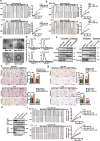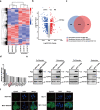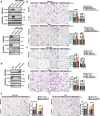Drug-resistant cancer cell-derived exosomal EphA2 promotes breast cancer metastasis via the EphA2-Ephrin A1 reverse signaling
- PMID: 33879771
- PMCID: PMC8058342
- DOI: 10.1038/s41419-021-03692-x
Drug-resistant cancer cell-derived exosomal EphA2 promotes breast cancer metastasis via the EphA2-Ephrin A1 reverse signaling
Abstract
Tumor metastasis induced by drug resistance is a major challenge in successful cancer treatment. Nevertheless, the mechanisms underlying the pro-invasive and metastatic ability of drug resistance remain elusive. Exosome-mediated intercellular communications between cancer cells and stromal cells in tumor microenvironment are required for cancer initiation and progression. Recent reports have shown that communications between cancer cells also promote tumor aggression. However, little attention has been regarded on this aspect. Herein, we demonstrated that drug-resistant cell-derived exosomes promoted the invasion of sensitive breast cancer cells. Quantitative proteomic analysis showed that EphA2 was rich in exosomes from drug-resistant cells. Exosomal EphA2 conferred the invasive/metastatic phenotype transfer from drug-resistant cells to sensitive cells. Moreover, exosomal EphA2 activated ERK1/2 signaling through the ligand Ephrin A1-dependent reverse pathway rather than the forward pathway, thereby promoting breast cancer progression. Our findings indicate the key functional role of exosomal EphA2 in the transmission of aggressive phenotype between cancer cells that do not rely on direct cell-cell contact. Our study also suggests that the increase of EphA2 in drug-resistant cell-derived exosomes may be an important mechanism of chemotherapy/drug resistance-induced breast cancer progression.
Conflict of interest statement
The authors declare no competing interests.
Figures







Similar articles
-
Exosomal EPHA2 derived from highly metastatic breast cancer cells promotes angiogenesis by activating the AMPK signaling pathway through Ephrin A1-EPHA2 forward signaling.Theranostics. 2022 May 13;12(9):4127-4146. doi: 10.7150/thno.72404. eCollection 2022. Theranostics. 2022. PMID: 35673569 Free PMC article.
-
Chemoresistance Transmission via Exosome-Mediated EphA2 Transfer in Pancreatic Cancer.Theranostics. 2018 Nov 13;8(21):5986-5994. doi: 10.7150/thno.26650. eCollection 2018. Theranostics. 2018. PMID: 30613276 Free PMC article.
-
The Ephrin-A1/EPHA2 Signaling Axis Regulates Glutamine Metabolism in HER2-Positive Breast Cancer.Cancer Res. 2016 Apr 1;76(7):1825-36. doi: 10.1158/0008-5472.CAN-15-0847. Epub 2016 Feb 1. Cancer Res. 2016. PMID: 26833123 Free PMC article.
-
Roles of EphA1/A2 and ephrin-A1 in cancer.Cancer Sci. 2019 Mar;110(3):841-848. doi: 10.1111/cas.13942. Epub 2019 Feb 15. Cancer Sci. 2019. PMID: 30657619 Free PMC article. Review.
-
The EphA2 receptor and ephrinA1 ligand in solid tumors: function and therapeutic targeting.Mol Cancer Res. 2008 Dec;6(12):1795-806. doi: 10.1158/1541-7786.MCR-08-0244. Mol Cancer Res. 2008. PMID: 19074825 Free PMC article. Review.
Cited by
-
Tumor-associated exosomes in cancer progression and therapeutic targets.MedComm (2020). 2024 Sep 7;5(9):e709. doi: 10.1002/mco2.709. eCollection 2024 Sep. MedComm (2020). 2024. PMID: 39247621 Free PMC article. Review.
-
Development of a Specific Aptamer-Modified Nano-System to Treat Esophageal Squamous Cell Carcinoma.Adv Sci (Weinh). 2024 Jul;11(28):e2309084. doi: 10.1002/advs.202309084. Epub 2024 May 5. Adv Sci (Weinh). 2024. PMID: 38704694 Free PMC article.
-
Diversity of Intercellular Communication Modes: A Cancer Biology Perspective.Cells. 2024 Mar 12;13(6):495. doi: 10.3390/cells13060495. Cells. 2024. PMID: 38534339 Free PMC article. Review.
-
Exosomes: new targets for understanding axon guidance in the developing central nervous system.Front Cell Dev Biol. 2025 Jan 9;12:1510862. doi: 10.3389/fcell.2024.1510862. eCollection 2024. Front Cell Dev Biol. 2025. PMID: 39850798 Free PMC article. Review.
-
Extracellular Vesicles as Mediators and Potential Targets in Combating Cancer Drug Resistance.Molecules. 2025 Jan 23;30(3):498. doi: 10.3390/molecules30030498. Molecules. 2025. PMID: 39942602 Free PMC article. Review.
References
Publication types
MeSH terms
Substances
LinkOut - more resources
Full Text Sources
Other Literature Sources
Medical
Molecular Biology Databases
Miscellaneous

